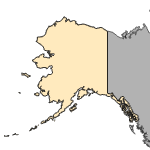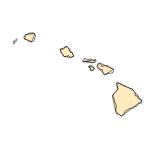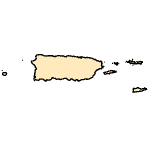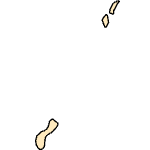Schizopera borutzkyi
(an oarsman)
Crustaceans-Copepods
Exotic |
|
Common name: an oarsman
Synonyms and Other Names: harpacticoid copepod
Taxonomy: available through
www.itis.gov
Identification: This copepod is distinguishable from many other harpacticoids that occur in the Great Lakes by its broad rostrum and long caudal rami (Horvath et al. 2001). Both the exopod and endopod on the first leg of S. borutzkyi are 3-segmented. The exopods have either 4 setae (on leg 1) or 4 spines (on leg 2) on the last segment. On the second segment of the exopod there is either 1 exterior spine (leg 1) or 1 interior spine (leg 2) (Lesko et al. 2003).
Size: 0.5–0.6 mm long. Males are typically shorter than females (Monchenko 1967; Horvath et al. 2001; Lesko et al. 2003).
Native Range: Schizopera borutzkyi is native to the Black Sea basin (Monchenko 1974, 1995; Horvath et al. 2001).



|

Alaska |

Hawaii |

Puerto Rico &
Virgin Islands |

Guam Saipan |
Hydrologic Unit Codes (HUCs) Explained
Interactive maps: Point Distribution Maps
Nonindigenous Occurrences:
Table 1. States with nonindigenous occurrences, the earliest and latest observations in each state, and the tally and names of HUCs with observations†. Names and dates are hyperlinked to their relevant specimen records. The list of references for all nonindigenous occurrences of Schizopera borutzkyi are found here.
Table last updated 12/5/2025
† Populations may not be currently present.
Ecology: In Lake Michigan, S. borutzkyi is found at depths of 6–15 m and has reached densities of 3700 m2 (Horvath et al. 2001). It was originally recorded in Europe by Monchenko (1967) in the Danube Delta region of the Black Sea on silt and sand at a pH of 7.6 and salinity of 0.04–6 ppt. Reproductive females carry two egg sacs ventrally (Lesko et al. 2003). The species can diapause, which likely contributed to its survival in ship ballast tanks (Panov et al. 2004).
Means of Introduction: The introduction of this species is attributable to ballast water release (Horvath et al. 2001).
Status: Established where recorded.
Impact of Introduction: A) Realised: altering species composition of nearshore communities. S. borutzkyi now dominates the harpacticoid community in deep sites (at 15 m) in Lake Michigan. This possibly reflects successful competition with native species for similar resources or the ability to exploit unused resources (Horvath et al. 2001).
B) Potential: Unknown.
References: (click for full references)
Garza, E.L., and R. L. Whitman. 2004. The nearshore benthic invertebrate community of southern Lake Michigan and its response to beach nourishment. Journal of Great Lakes Research 30(1): 114-122.
GLMRIS. 2012. Appendix C: Inventory of Available Controls for Aquatic Nuisance Species of Concern, Chicago Area Waterway System. U.S. Army Corps of Engineers.
Grippo, M.A., I. Hlohowskyj, L. Fox, B. Herman, J. Pothoff, C. Yoe, J. Hayse. 2017. Aquatic Nuisance Species in the Great Lakes and Mississippi River Basin--A Risk Assessment in Support of GLMRIS. Environmental Management 59(1): 154-173.
Horvath, T.G., R.L. Whitman, and L. L. Last. 2001. Establishment of two invasive crustaceans (Copepoda: Harpacticoida) in the nearshore sands of Lake Michigan. Canadian Journal of Fisheries and Aquatic Sciences 58: 1261-1264.
Lesko, L.T., P.L. Hudson, J.W. Reid, and M.A. Chriscinske. 2003. Harpacticoid copepods of the Laurentian Great Lakes. Great Lakes Science Center, Ann Arbor, Michigan. http://www.glsc.usgs.gov/greatlakescopepods/Key.asp?GROUP=Harpacticoid
Monchenko, V.I. 1967. Beitrag zur Kenntnis der Gattung Schizopera (Crustacea, Harpacticoida) im Schwarzen Meer. Zoologischer Anzeiger 178: 367-374.
Monchenko, V.I. 1974. New data on the distribution of rare harpacticoids off the northwestern shores of the Black Sea. Hydrobiologal Journal 10(5): 78-80.
Monchenko, V.I. 1995. Harpacticoida of River Dnieper (results of faunistic studies). Gidrobiologicheskii Zhurnal 31(5): 33-37.
Panov, V.E., P.I. Krylov, and N. Riccardi. 2004. Role of diapause in dispersal and invasion success by aquatic invertebrates. Journal of Limnology 63(Suppl. 1): 56-69.
Author:
Kipp, R.M., J. Larson, T.H. Makled, and A. Fusaro
Revision Date: 9/12/2019
Citation Information:
Kipp, R.M., J. Larson, T.H. Makled, and A. Fusaro, 2025, Schizopera borutzkyi Monchenko, 1967: U.S. Geological Survey, Nonindigenous Aquatic Species Database, Gainesville, FL, https://nas.er.usgs.gov/queries/FactSheet.aspx?speciesID=2374, Revision Date: 9/12/2019, Access Date: 12/5/2025
This information is preliminary or provisional and is subject to revision. It is being provided to meet the need for timely best science. The information has not received final approval by the U.S. Geological Survey (USGS) and is provided on the condition that neither the USGS nor the U.S. Government shall be held liable for any damages resulting from the authorized or unauthorized use of the information.